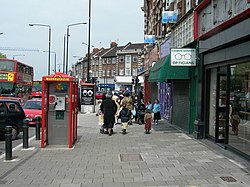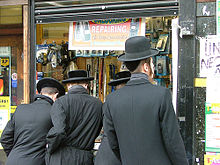Stamford Hill
| Stamford Hill | |
| Middlesex | |
|---|---|

| |
| Location | |
| Grid reference: | TQ335875 |
| Location: | 51°34’14"N, 0°4’22"W |
| Data | |
| Population: | 68,050 (2011) |
| Post town: | London |
| Postcode: | N16 / E5 |
| Dialling code: | 020 |
| Local Government | |
| Council: | Hackney |
| Parliamentary constituency: |
Hackney North and Stoke Newington |
Stamford Hill is a suburban village in easternmost Middlesex, about five and a half miles north-east of Charing Cross, sitting between Hackney to the north and Stoke Newington to the south. The River Lea marking the border of Essex flows by at the eastern edge of Stamford Hill.
The village is known for its Hasidic Jewish community; the largest concentration of Hasidic Jews in Europe.
The district takes its name from the eponymous hill, which reaches a height of 108 feet above sea level: the road heading north, the old Roman Ermine Street now the A10, also takes the name "Stamford Hill", as it makes its way through the area.
The hill is believed[1] to be named after the ford where Ermine Street crossed the Hackney Brook on the southern edge of the hill. Sanford and Saundfordhill are referred to in documents from the 1200s, and mean "sand Ford".[2] Roque's map of 1745 shows a bridge, which replaced the ford, referred to as "Stamford Bridge".[3]
The hill rises gently from the former course of the Hackney Brook to the south, and its steeper northern slope provided a natural boundary for the traditional parish of Hackney.
History
Stamford Hill lies on the old Roman road known as Ermine Street, on the high ground where it meets the Clapton Road, which runs from central Hackney. By the 18th century, the road was subject to heavy traffic, including goods wagons pulled by six or more horses, and this caused the surface of the road to deteriorate. The local parishes appealed to Parliament in 1713 for the right to set up a Turnpike Trust, to pay for repairs and maintenance. Gates were installed at Kingsland and Stamford Hill, to collect the tolls.[4]
John Roque's map of 1745 shows a handful of buildings around the Turnpike, and by 1795, the A10 was lined with the large homes and extensive grounds of wealthy financiers and merchants attracted, in part, by the elevated position.[5]
Stamford Hill had a gibbet, that was used to display the remains of criminals, executed at Tyburn in the 1740s. In 1765, a map of the area showed the Gibbet Field south of the road from Clapton Common, behind Cedar House.[1]
The area remained essentially rural in character, and little more was built until the arrival of the railway in 1872,[5] and the tram system at about the same time. Stamford Hill was the point where the tram line coming north from the City[6] met the Hackney tram line,[7] and so, it became a busy interchange, with a depot opening in 1873.[8] Electrification commenced in 1902 and by 1924 a service was commenced between Stamford Hill and Camden Town along Amhurst Park.
Stamford Hill had many eminent Jewish residents, including the Montefiore family. Italian-born Moses Vita Montefiore (died 1789) was living there in 1763. His son Joseph (died 1804) married Rachel Mocatta, and his grandson Abraham Montefiore (died 1824) married Henrietta, whose father, the financier Nathan Meyer Rothschild, lived near the modern Colberg Place from 1818 to 1835. The Montefiores' property a little further south was to be transformed by Abraham's grandson, Claude Montefiore, into Montefiore House school. With the increased development of the area, many distinguished families moved away: In 1842, there were few remaining of the wealthy Jews who had once settled in Hackney.[9] The philanthropist and abolitionist Member of Parliament, Samuel Morley had a residence here from about 1860. The gardening writer and cottage gardener Margery Fish was born Margery Townshend in Stamford Hill in 1892.[10]

From the 1880s, a new influx of Jews arrived from Stepney in the East End,[11] and, in 1915, the New Synagogue was transferred to Stamford Hill to serve this growing population. In 1926, the Union of Orthodox Hebrew Congregations was established in Stamford Hill, and this became a magnet for other strictly observant Jews, many fleeing Nazi persecution in the years before the Second World War.[9] Also, many Jewish families came to the area from other areas of London, refugees in their own way from bombing and post-war clearances for new housing. One of the early Hasidic leaders in Stamford Hill was the Shotzer Rebbe. The Hungarian uprising of 1956 also led to an influx of Haredi Jews fleeing hardship under Soviet rule. Another notable Jewish resident, from 1955 until his death in 2000, was the spiritual head of the Union of Orthodox Hebrew Congregations, Rabbi Chanoch Dov Padwa.
Haredi Jewish community

Stamford Hill is at the centre of an Ashkenazi ultra-Orthodox Jewish, and predominantly Hasidic, community estimated to be some 15,000 strong, and growing at a rate of around 5% each year.[12][13] It is the largest Hasidic community in Europe, and referred to as a square mile of piety,[9] reflecting the many Jewish men seen walking in their distinctive clothes on their way to and from worship. The congregations often represent historical links with particular areas of Eastern Europe in their dress and their worship. Many also retain links with congregations around the world. The largest of these congregations is the Satmar dynasty, which has five directly associated synagogues; Belz is another large community, with several synagogues. As well as Stamford Hill's own Jewish population, there are also many observant Jews in neighbouring Upper Clapton, West Hackney, Stoke Newington, and Tottenham; there may be as many as 50 synagogues in this wider area.
A volunteer emergency response first-aid service called Hatzola (the Hebrew word for 'rescue') and a volunteer community watch group called Shomrim (the Hebrew word for 'watchmen') are run by, and largely for, the Jewish community.[14]
The strictly Orthodox Jewish community relies mostly on private education for schooling, with almost all Jewish children attending private, single-sex Jewish schools.[15] In 2005, the Stamford Hill Yesodey Hatorah Senior Girls' School achieved voluntary-aided status.
There is also a notable population of Yemenite Jews, especially Adeni Jews who originated in the port city of Aden in Yemen. They settled in Stamford Hill, after fleeing the inter-community violence at the end of the Aden Protectorate. The Adeni Congregation synagogue, Nahalat Yosef, is named after the original Adeni synagogue in Yemen.[16]
In 2014, the community met with controversy after a sign was spotted in the location reading, "Women should please walk along this side of the road only".[17] The sign was reportedly put up for a Torah Procession parade, and was meant to provide directions for members who wished to avoid contact with the opposite sex.[17] After complaints about the sign were raised, a group of Shomrim who regularly police the area contacted the organisers to tell them that the posters "lacked explanation". The posters were removed, and the organisers agreed to take the signs down more quickly the following year.[18]
Since the 2011 census, there has been a migration of Stamford Hill Hasidic Jews to Canvey Island, in Essex. Canvey Island has a fairly homogenous ethnic make-up, and did not previously have a significant Jewish presence, but community relations appear to be good, and were the subject of a TV documentary.[19]
Outside links
References
- ↑ 1.0 1.1 A History of the County of Middlesex - Volume 10 pp 38-44: Hackney: Newington and Stamford Hill (Victoria County History)
- ↑ Ekwall, Eilert, The Concise Oxford Dictionary of English Place-Names. Oxford, Oxford University Press, 4th edition, 1960. ISBN 0198691033
- ↑ "Stoke Newington Common - Hackney Council". https://www.hackney.gov.uk/stoke-newington-common. Retrieved 2 September 2018.
- ↑ Georgian Transport (Brickfields Spitalfields) accessed 18 May 2009
- ↑ 5.0 5.1 The London Encyclopaedia, Weinreb and Hibbert, 1983
- ↑ The North Metropolitan Tramways Co. inaugurated 1872, and ran from Moorgate by way of Kingsland and Stoke Newington Roads to Stamford Hill
- ↑ The North Metropolitan from Bishopsgate ran through Mare Street, and thence to Clapton, opened in 1872, and was extended to Clapton Common in 1875, reaching Stamford Hill in 1902,
- ↑ A History of the County of Middlesex - Volume 10 pp 4-10: Hackney: Communications (Victoria County History)
- ↑ 9.0 9.1 9.2 A History of the County of Middlesex - Volume 10 pp 145-48: Hackney: Judaism (Victoria County History)
- ↑ ODNB entry by Catherine Horwood. Retrieved 2 November 2012. Pay-walled.
- ↑ Kosher in the country The Economist 1 June 2006 accessed 14 August 2007
- ↑ "Love Hackney - Love Hackney". http://www.destinationhackney.co.uk/neighbourhoods/stamford-hill.
- ↑ "Learning Trust". Archived from the original on 26 November 2010. https://web.archive.org/web/20101126040158/http://www.learningtrust.co.uk/schools/secondary_schools/docs/ss_brochure_2011/ss_brochure_2011_pdf15.pdf. Retrieved 25 March 2011.
- ↑ Jewish health service offers local care - BBC Health 19 January 2003 accessed on 11 December 2006
- ↑ Mick Brown (25 February 2011). "Inside the private world of London's ultra-Orthodox Jews". The Telegraph (London). https://www.telegraph.co.uk/news/newstopics/religion/8326339/Inside-the-private-world-of-Londons-ultra-Orthodox-Jews.html. Retrieved 2 March 2011.
- ↑ The synagogues are named for the book Nahalat Yosef by Shemu'el Yosef Yeshuah. The book is named for his father, but contains a systematic exposition of rabbinical law and ethics. A second part details his travels in Palestine and the particular customs of Adeni Jews. In The Jews of the British Crown Colony of Aden, Reuben Ahroni, pp. 170–1 (Brill, 1994) ISBN 90-04-10110-1
- ↑ 17.0 17.1 Saul, Heather. "Stamford Hill council removes 'unacceptable' posters telling women which side of the road to walk down". https://www.independent.co.uk/news/uk/home-news/london-council-removes-unacceptable-stamford-hill-posters-telling-women-which-side-of-the-road-to-walk-down-9746012.html. Retrieved 29 September 2014.
- ↑ Blundy, Rachel. "Hackney council removes 'unacceptable' posters telling women which side of the road they should walk on". The Evening Standard. https://www.standard.co.uk/news/london/hackney-council-removes-unacceptable-posters-telling-women-which-side-of-the-road-they-should-walk-on-9743995.html. Retrieved 29 September 2014.
- ↑ Jewish Chronicle article describing the migration and the BBC documentary https://www.thejc.com/culture/tv/tv-review-canvey-the-promised-island-1.451767